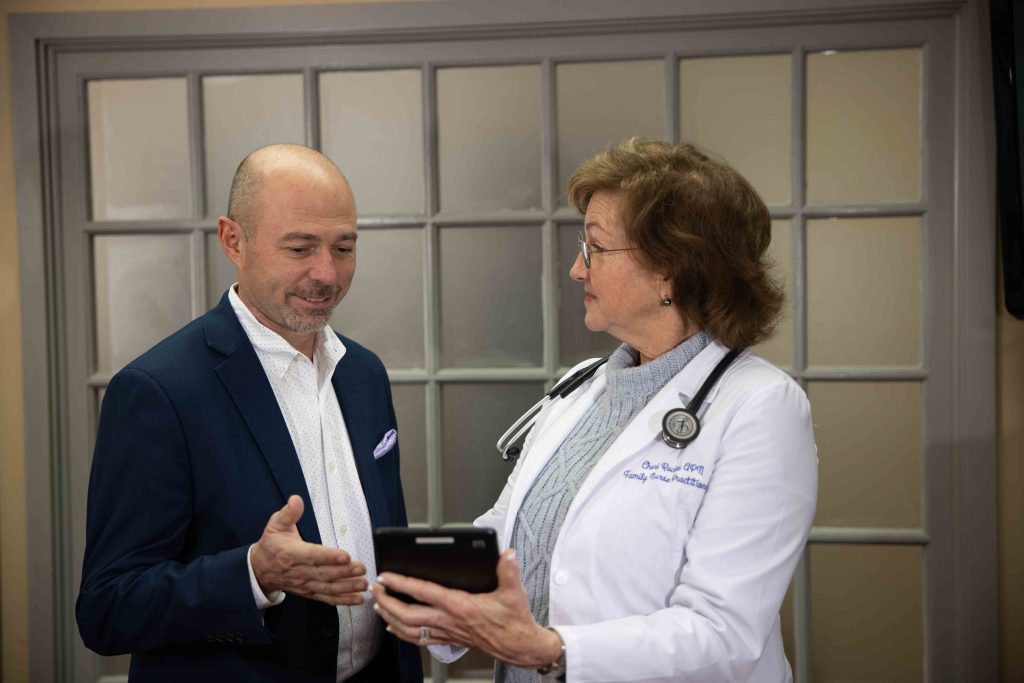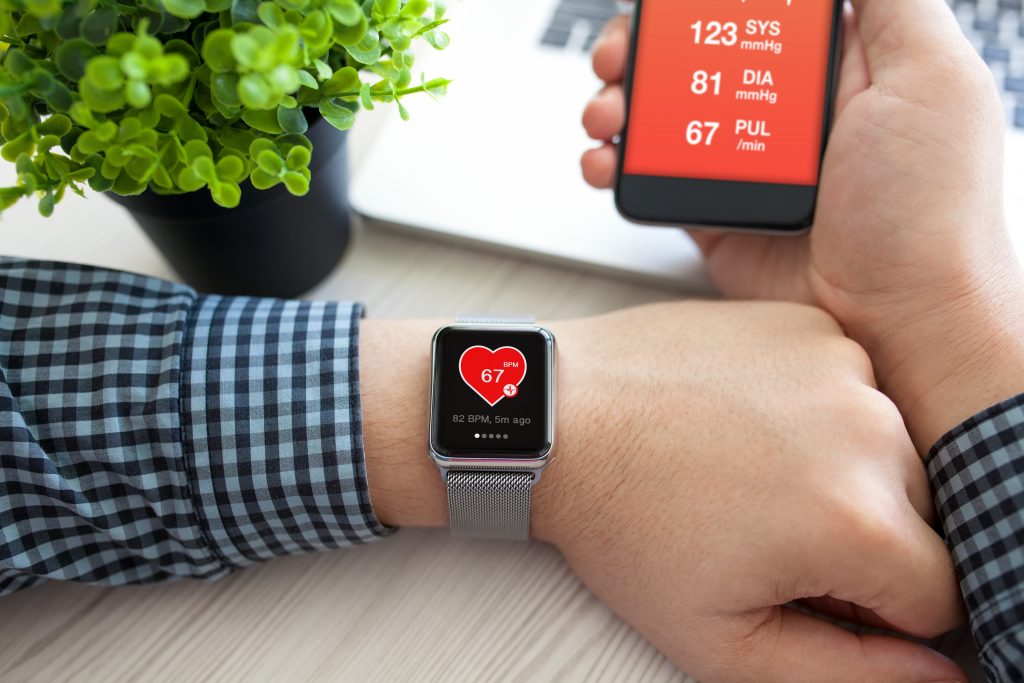Telehealth and at-home health monitoring devices
are becoming the ever-present future of healthcare
For David Kiger, home healthcare is a very personal matter. “My mother needed some help at home and her health was declining,” he recalls. “My siblings and I, of course, tried caregivers. After giving several a try, we finally found one that delivered the care my mom needed and wanted.” The caregiver made his mother’s life different, better, and he recalls the moments where they held her hand, consoling her when she needed it.

Kiger was inspired. He recognized how critical it was to be able to access care without ever leaving your house. “The experience with my mom made me realize that home monitoring devices are useful, not just to seniors with health issues or medical conditions, but to any individual who wants to watch their own health from home.”
Kiger founded Maryville-based Comet MD. The company couples telehealth with home monitoring devices—such as blood pressure cuffs, blood sugar monitors and oxygen sensors—to help patients monitor their health. The data from the devices is transmitted to a Comet MD nurse practitioner who monitors the readings and can take immediate action when necessary.
A changing landscape
Kiger’s company is just one example of how physicians and companies are tackling healthcare in this country right now. Today’s healthcare is a brave, new world, with innovation bringing about monumental changes in the way we live. We’ve seen this transformation before in the way we bank—financial institutions all but abandoning in-branch service in exchange for online convenience—and we’re witnessing a similar transformation in healthcare. Medical practices are shifting to offer expanded telehealth offerings, and companies, such as Comet MD, are becoming an updated option for individuals to access healthcare from home. And while this transformation has been in the works for years, COVID-19 has certainly quickened its pace.
From the younger individual who seldom sees a physician to the senior citizen who relies on regular home healthcare visits, Americans are now benefitting from this updated form of care delivery. An early 2020 physician survey from research firm Deloitte showed that right before COVID-19, physicians use of virtual health was gradually on the rise but many felt they didn’t have what they needed in their practices to make a more intense shift. “Most physicians were not intending to use many virtual health solutions, and those who were, for the most part, had only gradually increased their usage,” the survey results showed. The Centers for Disease Control and Prevention analyzed data from four of the largest telehealth providers in the United States and by late March 2020, telehealth visits had already increased by 154 percent, compared to that same period in 2019. When the pandemic hit full-force, however, things shifted even further. The intent to “go virtual” increased dramatically.
In an effort to help Americans stay safe while accessing needed healthcare, the U.S. Centers for Medicare and Medicaid Services (CMS) made temporary changes to telehealth regulations. By declaring a public health emergency, the secretary of the U.S. Department of Health and Human Services (HHS) was given the authority to waive certain telehealth restrictions for the duration of the emergency, and CMS gave other flexibilities through waivers provided in the CARES Act.
According to CMS, the changes included removing requirements that a patient must be an established one before initiating a virtual visit and receiving remote monitoring services, allowing for payments via smart phones and audio-only phone calls, modifying and simplifying consent forms and allowing telehealth visits to take place in both the patient’s and the clinician’s home, and payment parity for virtual or telephone visits.
CMS says these regulations will last until the end of the public health emergency. But while these flexibilities will likely be pulled back or modified when the emergency is declared over, telehealth is here to stay. Many expect CMS to take into consideration what was learned during the emergency and adopt many of these flexibilities on a permanent basis as we move beyond the pandemic. Telehealth is now poised to become a central part of the healthcare delivery system.
“Like the pivot we’ve had to quickly make in education—from in person to remote learning—telehealth suddenly found itself on the front burner,” says Richard Briggs, cardiothoracic surgeon and Tennessee State Senator. “There is no doubt that Tennesseans love telehealth. We need physicians, regulatory agencies, insurance providers, the state government, and others to continue to work together and make it work for everyone.”
The benefits and challenges
The value of having telehealth in place is immense, especially during a pandemic. And having companies working in this arena alongside physician practices is an added bonus. “Individuals in need of healthcare, seniors in particular, need to have a comfort level with their physician,” says Kiger. “Many have had the same physician for years and years. In addition, they need easy, cost-effective access to at-home monitoring devices.”
These are just a few of the things Kiger and his team are tackling in their work. Cheri Racine, a certified family nurse practitioner who works with Kiger in the telehealth side of his business, says the opportunity to use this burgeoning form of healthcare has been critical: “I know that what I do gives my patients not just health care advice, but both comfort and confidence.” Racine provides medical advice to patients who aren’t able to access their primary care doctor and monitors their vital signs using the at-home devices. “We do not want to take away anything from the primary care physician,” Kiger says. “We want to help bridge the gap between medical and non-medical care while helping patients maintain that personal, comfortable relationship with their personal physician.”
No one is less surprised by the prediction of telehealth as a central component of our healthcare system than Briggs, who laconically sums up his opinion on it with three words: “Patients love it.” That’s not to say he feels telehealth is not without its challenges.
“Under ordinary circumstance, the strides that telehealth has made in the last several months would have taken years,” Briggs says. “I am still very concerned, however, about both the remaining challenges and the availability of quality healthcare to many Tennesseans.”
This is an important point to make. Even with the increased use of telehealth, there are still many roadblocks that remain. “Many in Tennessee still do not have access to the quality care they need, particularly in areas such as cardiology and mental health,” Briggs says. In addition, there are concerns around appropriate physician compensation and Medicare reimbursement, as well as issues around HIPAA confidentiality. Even broadband is a challenge. Many want to use telehealth, but basic internet access is limited, something not always considered as the use becomes more widespread.
“The goal is to bring quality healthcare to everyone in the state and, ironically, those who are in the most need are still not getting the care they need…all because of internet access,” Briggs says. “We’re working on that right now and hope to see drastic improvements in the very near future.”

A helpful tool
As the use of telehealth continues to grow across the country, other home health industries continue to as well. Sophisticated, wearable monitoring devices—something that’s not new to the health and wellness landscape by any means—have become increasingly used. Yes Apple watches and FitBit-like devices, but also wearable devices that monitor heart rate, blood pressure, blood sugar, even electrocardiograms. According to research from Business Insider Intelligence, use of these devices increased from 9 to 33 percent in the United States in the last four years. This same research predicts that that number is only expected to grow: “The total installed base of fitness tracker and health-based wearables in the U.S. will grow at an annualized rate of 10 percent to surpass 120 million by 2023.”
Deloitte predicts that by 2040 healthcare will look entirely different: “Through science, data, and technology, we will be able to identify diseases earlier, intervene proactively, and better understand their progression to help consumers more effectively and actively sustain their well-being.” The focus will be on wellness, with the goal to promote healthy living and increased access to high quality care.
Even with all the innovation, do we have a clear picture of home healthcare’s future? Not yet. Care providers are encouraged by the recent, positive changes in telehealth, but still have concerns. Regulation and compliance, physician compensation and practice revenues, the availability of telehealth care, and the ability to maintain that personal physician-patient relationship are all challenges which industry professionals are working hard to address. One thing, though, is clear to all: As the focus shifts from a traditional healthcare model to a model driven by data sharing, sophisticated health monitoring devices and widely available telehealth services, Tennesseans can definitely look forward to living healthier, happier lives.
